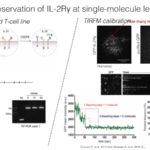Link to Pubmed [PMID] – 24855645
J. Biol. Chem. 2014 Jul;289(27):19042-52
CCR5 binds the chemokines CCL3, CCL4, and CCL5 and is the major coreceptor for HIV-1 entry into target cells. Chemokines are supposed to form a natural barrier against human immunodeficiency virus, type 1 (HIV-1) infection. However, we showed that their antiviral activity is limited by CCR5 adopting low-chemokine affinity conformations at the cell surface. Here, we investigated whether a pool of CCR5 that is not stabilized by chemokines could represent a target for inhibiting HIV infection. We exploited the characteristics of the chemokine analog PSC-RANTES (N-α-(n-nonanoyl)-des-Ser(1)-[l-thioprolyl(2), l-cyclohexylglycyl(3)]-RANTES(4-68)), which displays potent anti-HIV-1 activity. We show that native chemokines fail to prevent high-affinity binding of PSC-RANTES, analog-mediated calcium release (in desensitization assays), and analog-mediated CCR5 internalization. These results indicate that a pool of spare CCR5 may bind PSC-RANTES but not native chemokines. Improved recognition of CCR5 by PSC-RANTES may explain why the analog promotes higher amounts of β-arrestin 2·CCR5 complexes, thereby increasing CCR5 down-regulation and HIV-1 inhibition. Together, these results highlight that spare CCR5, which might permit HIV-1 to escape from chemokines, should be targeted for efficient viral blockade.







